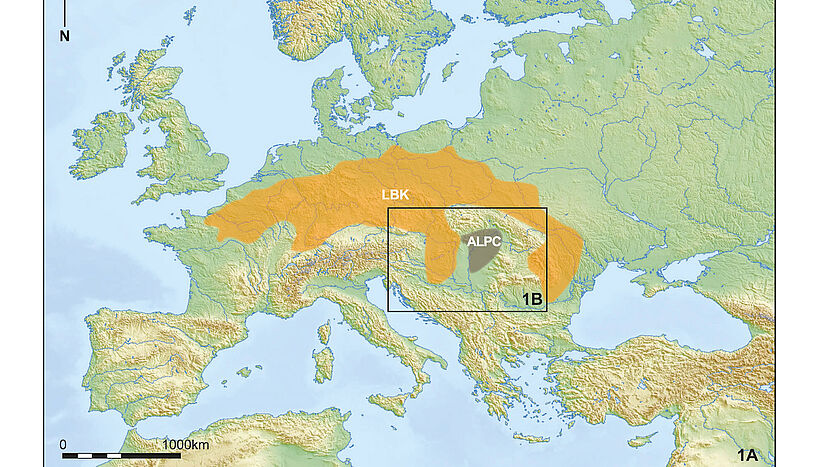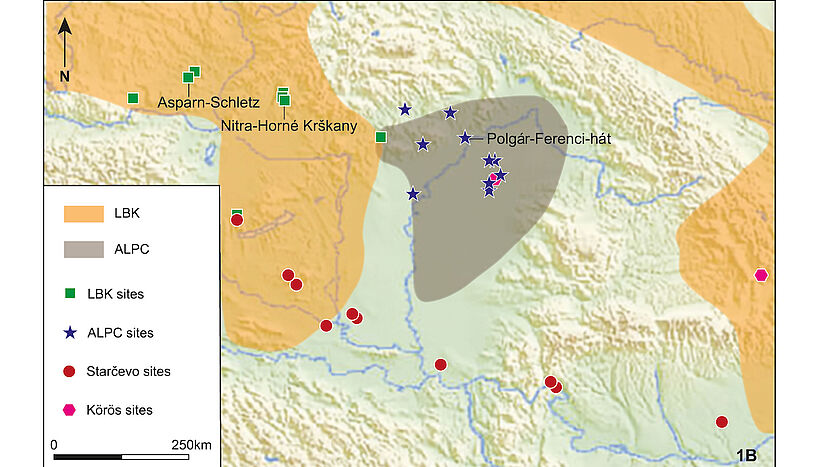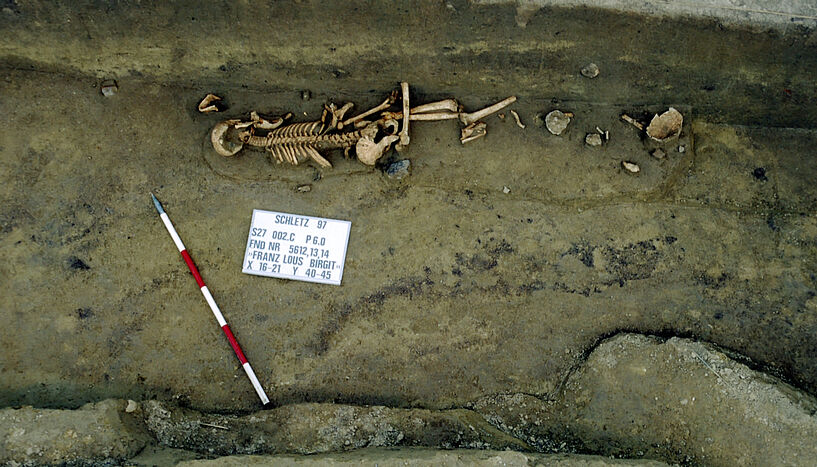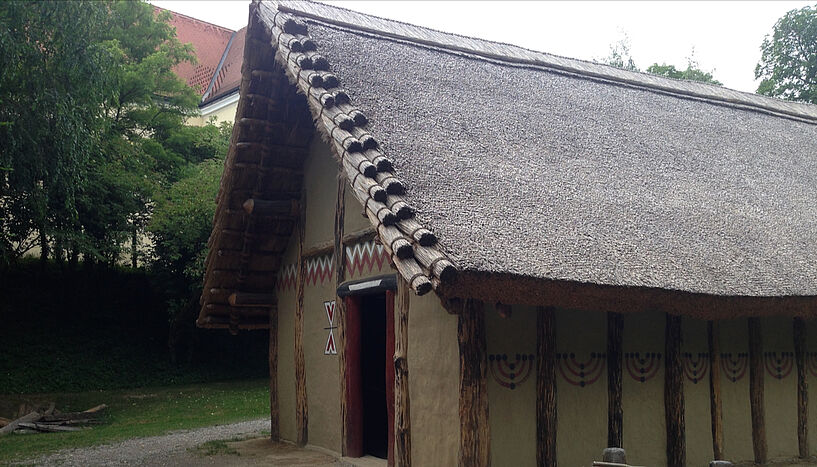Sharing is Caring: Central Europe’s First Farmers Lived in Equality
29. November 2024Genetic study also reveals long-distance travelling in Neolithic societies
An international team of researchers led by Pere Gelabert and Ron Pinhasi of the University of Vienna and David Reich of Harvard University has produced the most complete set of Early Neolithic genetic data from Central Europe to date. The results of this study, just published in Nature Human Behaviour, reveal that the culture responsible for the expansion of agriculture in Central Europe 8,000 years ago showed no signs of population stratification.
The expansion of agriculture in Central Europe took place in the sixth millennium BC. Within a few generations, farmers from the Balkan region expanded down the Danube valley into present-day France and eastward into present-day Hungary and Ukraine. The cultural traces of the farmers are homogeneous across this area, spanning thousands of kilometers – but the lack of genetic data from multiple families makes it difficult to understand whether these communities lived in social equality, or to assess which individuals were the ones who migrated across the continent.
Long-distance travellers
A research team of more than 80 geneticists, anthropologists, and archaeologists studying the social particularities of the Linear Pottery Culture (Linearbandkeramik, LBK) has integrated new genetic data from more than 250 individuals with extensive data sets: bone studies, radiocarbon dates, burial contexts, and dietary data. Studying the genetic links between those Neolithic individuals has shown that the LBK people expanded over hundreds of kilometers in just a few generations. First and corresponding author Pere Gelabert, scientist at the Department of Evolutionary Anthropology, University of Vienna, says: "We have successfully found distant relatives in Slovakia and others in Western Germany, more than 800 km away."
Lack of social stratification
"In this study," corresponding author Ron Pinhasi explains, "we report for the first time that families at the study sites of Nitra in Slovakia and Polgár-Ferenci-hát in Hungary do not differ in terms of the foods they consumed, the grave goods they were buried with, or their origins. This suggests that the people living in these Neolithic sites were not stratified on the basis of family or biological sex, and we do not detect signs of inequality, understood as differential access to resources or space".
Brutality in ancient times
The LBK culture came to an end around 5000 BCE, and various hypotheses have been proposed regarding its collapse. Some suggest that it was a period of social and economic crisis, often associated with episodes of widespread violence. One of the most famous events is the Massacre of Asparn-Schletz (Lower Austria), where over 100 individuals were recovered from a ditch system. Along with Herxheim (Germany), this site represents one of the largest known assemblages of violently killed individuals during the Early Neolithic, with skeletons showing signs of violence and multiple fractures. Pere Gelabert on this subject: "Our meticulous genetic study of the Asparn-Schletz individuals showed that less than 10 were genetically related, which challenges the hypothesis that the massacre represented a single population". Previous anthropological studies by a team of bioanthropologists led by Maria Teschler-Nicola from the Natural History Museum Vienna noted a lack of young women, and the new data further confirm a complete absence of relatives. The presence of many children among the victims opens the door to multiple interpretations of this remarkable event of Neolithic violence.
Original publication:
Pere Gelabert, Penny Bickle, Daniela Hofmann, Maria Teschler-Nicola, Alexandra Anders, Xin Huang, Michelle Hämmerle, Iñigo Olalde, Romain Fournier, Harald Ringbauer, Ali Akbari, Olivia Cheronet, Iosif Lazaridis, Nasreen Broomandkhoshbacht, Daniel M. Fernandes, Katharina Buttinger, Kim Callan, Francesca Candilio, Guillermo Bravo Morante, Eliznabeth Curtis, Matthew Ferry, Denise Keating, Suzanne Freilich, Aisling Kearns, Éadaoin Harney, Ann Marie Lawson, Kirsten Mandl, Megan Michel, Victoria Oberreiter, Brina Zagorc, Jonas Oppenheimer, Susanna Sawyer, Constanze Schattke, Kadir Toykan Özdoğan, Lijun Qiu, J. Noah Workman, Fatma Zalzala, Swapan Mallick Matthew Mah, Adam Micco, Franz Pieler, Juraj Pavuk, Alena Šefčáková, Catalin Lazar, Andrej Starović, Marija Djuric, Maja Krznarić Škrivanko, Mario Šlaus23, Željka Bedić, Friederike Novotny, László D. Szabó, Orsolya Cserpák-Laczi, Tamara Hága, László Szolnoki, Zsigmond Hajdú, Pavel Mirea, Emese Gyöngyvér Nagy, Zsuzsanna M. Virág, Attila M. Horváth, László András Horváth, Katalin T. Biró, László Domboróczki, Tamás Szeniczey, János Jakucs, Márta Szelekovszky, Zoltán Farkas, Sándor József Sztáncsuj, Krisztián Tóth, Piroska Csengeri, Ildikó Pap, Róbert Patay, Anđelka Putica, Branislav Vasov, Bálint Havasi, Katalin Sebők, Pál Raczky, Gabriella Lovász, Zdeněk Tvrdý, Nadin Rohland, Mario Novak, Matej Ruttkay, Maria Krošláková, Jozef Bátora, Tibor Paluch, Dušan Borić, János Dani, Martin Kuhlwilm, Pier Francesco Palamara, Tamás Hajdu, Ron Pinhasi and David Reich. Social and genetic diversity in first farmers of central Europe. Nature Human Behaviour.
DOI: https://www.nature.com/articles/s41562-024-02034-z
Pictures:
Fig. 1 and Fig. 2: Map of the LBK culture and the studied sites (This is one of the figures from the paper)
Fig. 3 and Fig. 4: Skeletons from the Asparn-Schletz Massacre (C: Landessammlungen Niederösterreich "resp." C: State Collections of Lower Austria)
Fig. 5: LBK Longhaus, typical LBK house, reconstruction in the MAMUZ museum (Asparn/Zaya) C: Penny Bickle
Scientific contact
Pere Gelabert, PhD
Department für Evolutionäre AnthropologieUniversität Wien
1030 - Wien, Djerassiplatz 1
+43-1-4277-54714
pere.gelabert@univie.ac.at
Further inquiry
Mag. Alexandra Frey
Media Relations ManagerUniversität Wien
1010 - Wien, Universitätsring 1
+43-1-4277-17533
+43-664-8175675
alexandra.frey@univie.ac.at
Downloads:
20241021_Gelabert_Abb1_01.jpg
File size: 580,02 KB
20241021_Gelabert_Abb2_01.jpg
File size: 272,63 KB
20241021_Gelabert_Abb3_01.jpg
File size: 2,53 MB
20241021_Gelabert_Abb4_01.jpg
File size: 2,16 MB
20241021_Gelabert_Abb5_01.JPG
File size: 3,43 MB





